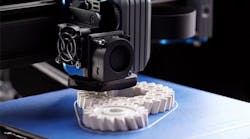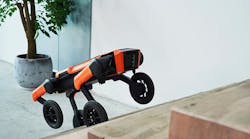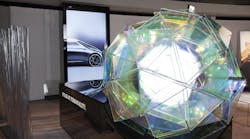According to a new study by Stratasys Direct Manufacturing, manufacturers aren't looking to 3D printing for just prototypes anymore. They want end-use metal parts. And they want them soon.
"3D printing is revolutionizing manufacturing," notes Stratasys Direct Manufacturing CEO, Joe Allison. "It's literally changing the way products are being manufactured."
This is a basic understanding at SDM, part of 3D printing giant Stratasys' contract additive manufacturing wing.
Churning out 3D-printed parts and pieces for manufacturers across the country, Allison sees his company as a champion for a new paradigm in manufacturing. His services are allowing manufacturers to create new designs and new concepts that are ready for real industrial application.
Services like his, he argues, are fundamentally changing the industry.
That's fine on Allison's end. But there remains a bit of a mystery as to what exactly these manufacturing customers actually want out of the technology.
To get a better sense of this, Allison says, they had to look beyond their own walls.
So Stratasys sponsored an independent blind study of North American manufacturers asking them what role 3D printing will play in their markets and businesses, what they want and need out of additive technology, and how exactly they plan to apply it in the next three years.
The results, published this morning in a report called, "TREND FORECAST: 3D Printing's Imminent Impact on Manufacturing" paints a picture of a rapidly changing 3D printing landscape.
This is a basic understanding at SDM, part of 3D printing giant Stratasys' contract additive manufacturing wing.
Churning out 3D-printed parts and pieces for manufacturers across the country, Allison sees his company as a champion for a new paradigm in manufacturing. His services are allowing manufacturers to create new designs and new concepts that are ready for real industrial application.
Services like his, he argues, are fundamentally changing the industry.
That's fine on Allison's end. But there remains a bit of a mystery as to what exactly these manufacturing customers actually want out of the technology.
To get a better sense of this, Allison says, they had to look beyond their own walls.
So Stratasys sponsored an independent blind study of North American manufacturers asking them what role 3D printing will play in their markets and businesses, what they want and need out of additive technology, and how exactly they plan to apply it in the next three years.
The results, published this morning in a report called, "TREND FORECAST: 3D Printing's Imminent Impact on Manufacturing" paints a picture of a rapidly changing 3D printing landscape.
While additive manufacturing's roots are in prototypes and proof-of-concept models, the results of the study show modern users want something much more.
According to the report, users show a 38% increase in interest in 3D printed end-use parts—a growth almost entirely led by 3D printing bureaus like SDM.
This marks an important shift in the market.
"For 15 years 3D printing has been changing the way prototypes are made," Allison said at the report launch earlier this week in Austin. "Now it's changing the way real parts are made."
Adding to that movement, the vast majority of respondents indicated a strong interest in the development of metal materials for 3D printing, another big jump from the technology's roots.
According to the report, users show a 38% increase in interest in 3D printed end-use parts—a growth almost entirely led by 3D printing bureaus like SDM.
This marks an important shift in the market.
"For 15 years 3D printing has been changing the way prototypes are made," Allison said at the report launch earlier this week in Austin. "Now it's changing the way real parts are made."
Adding to that movement, the vast majority of respondents indicated a strong interest in the development of metal materials for 3D printing, another big jump from the technology's roots.
Metal printing, of course, means Direct Laser Metal Sintering technology – an intricate process that involves printing with sensitive, expensive equipment, and an extensive post processing process that requires everything from multi-axis CNCs to MFAs with hammers and chisels (seriously) to get the parts into spec.
This all adds up to an extremely high barrier for entry into 3D printing, which is at the very top of users' concerns in the market.
However, it also serves to validate Allison's theory of the market.
3D printing is actually changing the way things are made. Users are no longer interested in just prototypes or models. They want the real thing. They want to apply these technologies to real-life parts and real-life applications—a shift that puts SDM and bureaus like it suddenly at the front line of a manufacturing revolution.
Adding it all up, and it really starts to seem like we might be at the long-awaited inflection point where these technologies become a mainstream solution in a manufacturer's toolbox.
Joe Allison, isn't quite sure, however.
"No survey can tell us whether we've reached the inflection point; only time will tell," he writes in the report. "But make no mistake: 3D printing is here and now.
"We're building real production parts in every field you can think of, across a wide range of applications today. For any manufacturers out there that haven't started using 3D printing, they better start looking at it now, or they'll fall behind and it will be difficult to catch up."
3D printing is actually changing the way things are made. Users are no longer interested in just prototypes or models. They want the real thing. They want to apply these technologies to real-life parts and real-life applications—a shift that puts SDM and bureaus like it suddenly at the front line of a manufacturing revolution.
Adding it all up, and it really starts to seem like we might be at the long-awaited inflection point where these technologies become a mainstream solution in a manufacturer's toolbox.
Joe Allison, isn't quite sure, however.
"No survey can tell us whether we've reached the inflection point; only time will tell," he writes in the report. "But make no mistake: 3D printing is here and now.
"We're building real production parts in every field you can think of, across a wide range of applications today. For any manufacturers out there that haven't started using 3D printing, they better start looking at it now, or they'll fall behind and it will be difficult to catch up."










